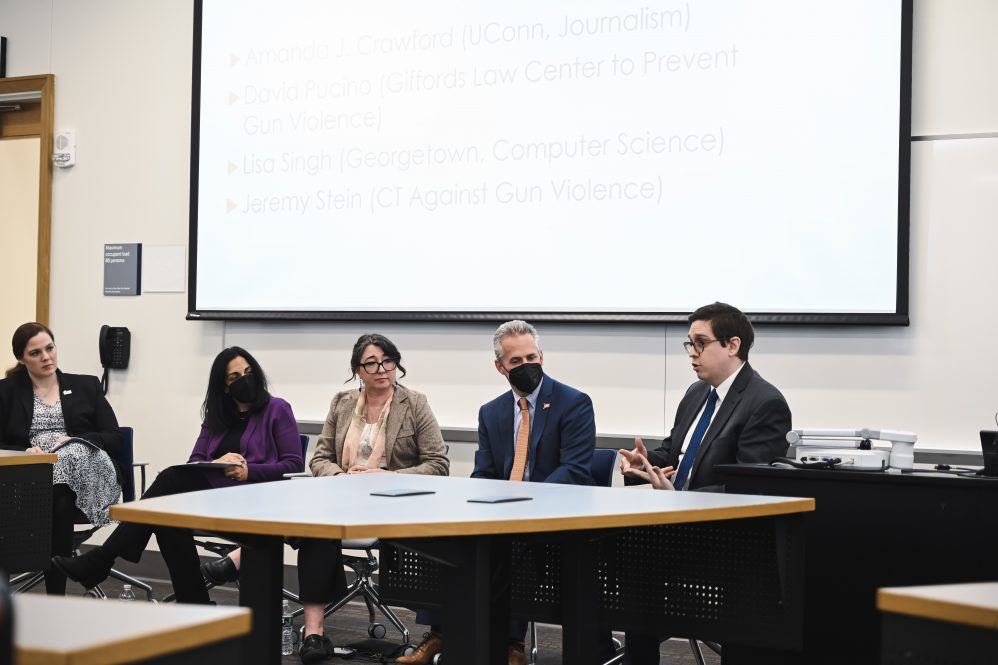The Gun Violence Prevention – Research Interest Group, a part of the UConn ARMS Center (Advancing Research, Methods, and Scholarship for Gun Injury Prevention), recently hosted a panel on gun violence and policy misinformation at the UConn Hartford Campus.
ARMS is housed within the Institute of Collaboration on Health, Intervention, and Policy (InCHIP) and is affiliated with the School of Public Policy.
Kerri Raissian, UConn associate professor of public policy and ARMS director, moderated the panel which included Amanda J Crawford, UConn assistant professor of journalism; Jeremy Stein, executive director of CT Against Gun Violence (CAGV); David Pucino, deputy chief counsel at Giffords Law Center to Prevent Gun Violence; and Lisa Singh, professor of computer science and a research professor in the Massive Data Institute (MDI) at Georgetown University.
The goal of the public panel was to demonstrate that misinformation is present in America’s gun policy debates and to facilitate conversation about how misinformation shapes our country’s policy debates and outcomes.
“We see misinformation as a critical barrier to effective and informed policy,” Raissian says. “It’s hard to do anything well from a place of misinformation.”
Raissian says convening this interdisciplinary panel reflects the complex nature of gun violence and its impacts.
“Gun violence and injury happens for lots of different reasons [and] it happens to lots of different communities,” Raissian says. “In order for us to solve multi-faceted problems, we need to have an interdisciplinary conversation.”
Gun violence has become a fertile ground for misinformation including denying the reality of mass shootings, misleading messaging from lobbying groups, and the deceptive use of statistics.
Raissian says even seemingly innocuous phrases like “guns don’t kill people, people kill people,” can be misleading. She points out that it is well documented that when guns become more readily available, more people die from gun violence.
“ARMS and the GVP-RIG exist to understand why that is and to figure out ways to reduce gun related injury and death while preserving people’s second amendment rights to own a firearm.,” Raissian says. “But we can only get there if we are working with honest information.”
One major misconception the panel sought to address was people’s perceptions of who is a victim of gun violence. While many people associate gun violence with urban areas, guns also play a prominent role in deaths by suicide and domestic violence which happens in communities across America.
Raissian believes research can and must be used to prevent all forms of gun violence.
The panelists and audience also discussed the distinction between being “underinformed,” which is when there might not be enough information available about gun violence or when people have not sought out information about gun violence – such as who is impacted by gun violence. She contrasts this being “misinformed,” which is when someone consumes content that is purposefully inaccurate and aims at swaying the reader or viewer to a particular point of view.
“Misinformation can be particularly dangerous, because when people’s views are formed from misinformation, they tend to have more entrenched views compared to those that are underinformed,” Raissian says.
Connecticut has an especially fraught relationship with gun violence misinformation. After the mass shooting at Sandy Hook Elementary School in 2012, misinformation and conspiracy theories proliferated. This compounds the survivors’ trauma and thwarts effective policy solutions.
Misinformation around gun violence has even found a foothold on the national policy stage. A doctored photo of David Chipman, President Joe Biden’s nominee for director of the Bureau of Alcohol, Tobacco, Firearms and Explosives, showed him holding a sign calling pro-gun activists “bullies” became a prominent talking point during Chipman’s nomination hearings. The nomination ultimately failed.
“While ARMS does not endorse candidates and potential appointments for any particular position, we do want our senators to think about those decisions with accurate information.” Raissian says.
The approximately 40 panel attendees included students, community members, policy makers, advocates, scholars, and gun owners, and non-gun owners.
“It’s really important for us that both of all of these groups are brought into policy conversations,” Raissian says.
Raissian says one of the most powerful ways to counter misinformation is for scholars to share and discuss their research with the public, such as through panels.
“One of the best ways to combat misinformation is with information,” Raissian says.



